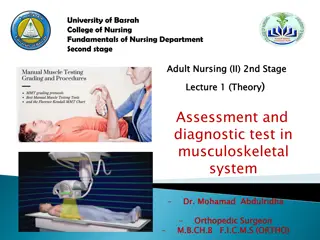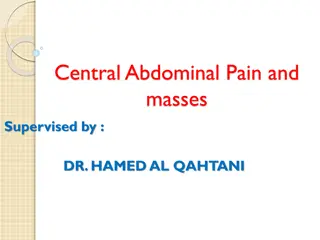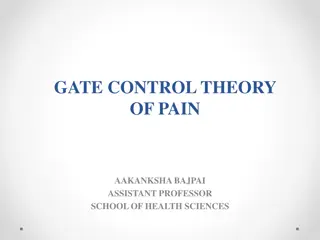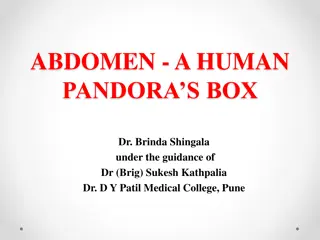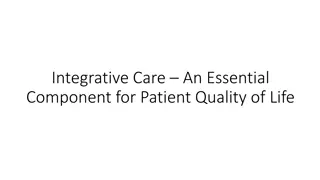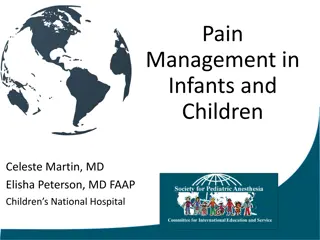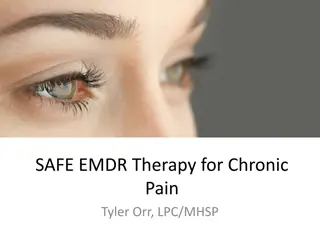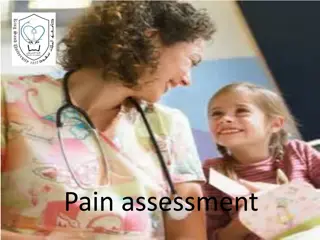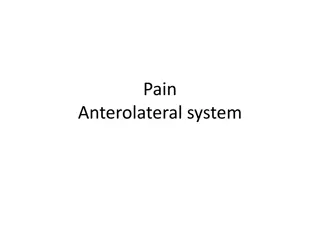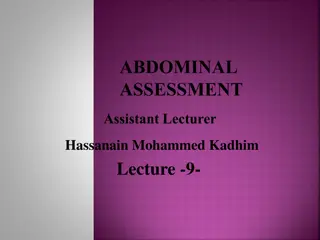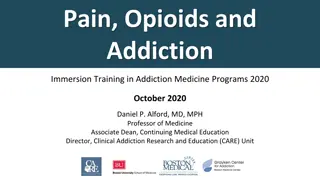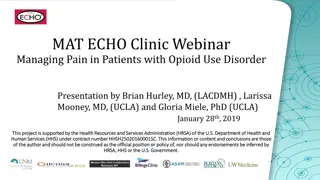Integrative Care of a Child with Abdominal Pain
This case presentation explores the integrative care of a 7-year-old child experiencing functional abdominal pain. Analyzing the case, describing pathophysiology theories, and evaluating treatment options based on research are key aspects covered.
Download Presentation

Please find below an Image/Link to download the presentation.
The content on the website is provided AS IS for your information and personal use only. It may not be sold, licensed, or shared on other websites without obtaining consent from the author.If you encounter any issues during the download, it is possible that the publisher has removed the file from their server.
You are allowed to download the files provided on this website for personal or commercial use, subject to the condition that they are used lawfully. All files are the property of their respective owners.
The content on the website is provided AS IS for your information and personal use only. It may not be sold, licensed, or shared on other websites without obtaining consent from the author.
E N D
Presentation Transcript
CASE PRESENTATION: THE INTEGRATIVE CARE OF A CHILD WITH FUNCTIONAL ABDOMINAL PAIN PATRI CI A ESTR AD A, MSN( C) , RN I NTEGR ATI VE HE ALTH FALL 2 0 1 8
OBJECTIVES OBJECTIVES After attending this case presentation, participants will be able to: Analyze a case presentation of a 7 year old child with Recurrent Abdominal Pain (RAP) Describe the theories for the pathophysiology associated with RAP Identify the Rome IV criteria for recurrent abdominal pain, specifically functional abdominal pain (FAP) Evaluate treatment options based on high- quality research
PRESENT THE PATIENT: PRESENT THE PATIENT: DEMOGRAPHICS DEMOGRAPHICS A 7-year-old female pediatric patient presents with daily generalized abdominal pain lasting for 30 minutes to 2 hours, beginning 2 years ago around the start of kindergarten, occurring most often before and after school. She also has daily mild headaches usually occurring after school that have been happening for about the same amount of time.
PRESENT THE PATIENT: PRESENT THE PATIENT: HISTORY HISTORY A well child with no other significant medical, trauma, birth, or psychiatric history. Up to date on vax. Lives with mother, father, younger sister. Family History negative for bowel or abdominal problems positive migraine headaches: mother and maternal grandfather positive for anxiety: mother, maternal aunt, maternal grandfather positive for depression: maternal aunt
PRESENT THE PATIENT: PRESENT THE PATIENT: MEDICATIONS AND CAM MEDICATIONS AND CAM List of Medications & Supplements Gummy multivitamin (2 times per week) Acetaminophen 325mg PO (~2 times/week) Probiotics (refuses due to increased bowel movements at school) Use of CAM including lifestyle modification Cool and warm compress (ineffective) Diet changes: eats moderately healthy, school lunches, lactose free milk but eats cheese and ice cream, unresponsive to gluten free
PRESENT THE PATIENT: PRESENT THE PATIENT: REVIEW OF SYSTEMS (SUBJECTIVE) REVIEW OF SYSTEMS (SUBJECTIVE) Abdominal pain, does not always finish meal due to stomach pain. Daily formed BM. Headaches daily to 3 days per week, occasionally prevents participation in sports, ADLs, activities No weight curve changes, no nausea, vomiting, diarrhea, fever, bloody stools or rashes; No head injury or trauma, vertigo, weakness, or confusion; Normal full eye exam, normal vision; No depressive symptoms, normal sleep habits Occasional, once weekly, bilateral leg pain, aching in the evening, resolved after sleep
OBJECTIVE General: healthy appearing, well groomed, bright affect, laughing and playing, thoughtful Neurologic: A&O, coherent, speech clear. CN 2- 12 intact, motor movements coordinated, no weakness Eyes: Visual acuity intact, lid margins clear, conjunctiva pink, sclera anicteric, PERRLA. Abdomen: Abdomen flat, normo-active BS present. No localized tenderness on abdominal palpation. No masses. Liver border not palpable FSBS 99, UA wnl, CBC wnl, ESR wnl, XR neg
ASSESSMENT RECURRENT ABDOMINAL PAIN Further separated as Functional (nonorganic) Abdominal Pain (FAP) Established by presenting clinical features based on the Rome IV criteria. Abdominal pain at least 4 times per month (for at least two months) Not associated with eating or menses Does not meet criteria for abdominal migraine, functional dyspepsia, irritable bowel syndrome
PRESENTATION OF THE PRESENTATION OF THE CLINICAL PROBLEM CLINICAL PROBLEM Epidemiology (for RAP) Up to 5% of primary care visits, worldwide affects 13.5% of children Divisions of RAP Functional abdominal pain: 53.8% Irritable bowel syndrome: 38.5% Functional dyspepsia: 7.7%
PRESENTATION OF THE PRESENTATION OF THE CLINICAL PROBLEM CLINICAL PROBLEM Etiology/Pathophysiology Many pathophysiologic pathways have been suggested including altered gastrointestinal microbiota, mucosa or motility, altered immune system or central nervous system function, or visceral hypersensitivity (Newlove-Delgado et al., 2017). Psychosocial factors have also been implicated in the symptom cluster.
PRESENTATION OF THE PRESENTATION OF THE CLINICAL PROBLEM CLINICAL PROBLEM Signs and Symptoms Primary symptom is abdominal pain Other symptoms are also associated with RAP in children including headache, anxiety and emotional disorders, trouble sleeping and limb pain. The abdominal pain may cause some loss of daily functioning and many children loose time spent in schooling or other activities (Rasquin et al., 2006).
PRESENTATION OF THE PRESENTATION OF THE CLINICAL PROBLEM CLINICAL PROBLEM Treatments and Evidence: Probiotics Implication of gastrointestinal microbiota in the pathophysiology RAP. Probiotics contain living micro-organisms which alter the normal microbiota of the intestinal tract. A systematic review found improvement in pain, a reduction in pain frequency and decrease in pain intensity in children who were taking probiotics (Newlove-Delgado et al., 2017).
PRESENTATION OF THE PRESENTATION OF THE CLINICAL PROBLEM CLINICAL PROBLEM Treatments and Evidence: Peppermint Peppermint has been shown to reduce abdominal pain in children with IBS (Rakel, 2017) and may help reduce pain in FAP through it s antispasmotic effects.
PRESENTATION OF THE PRESENTATION OF THE CLINICAL PROBLEM CLINICAL PROBLEM Treatments and Evidence: Hypnotherapy Hypnotherapy including guided imagery has shown some success for reduced pain frequency and intensity in children with RAP (Abbott et al., 2017). Guided imagery activates portions of the brain and can create a response that may facilitate pain reduction through relaxation and pain relief suggestion (Rakel, 2017).
PRESENTATION OF THE PRESENTATION OF THE CLINICAL PROBLEM CLINICAL PROBLEM Treatments and Evidence: Biofeedback Biofeedback has been shown to be a good tool to use to show the effect of mindful relaxation on the physical body (Rakel, 2017). One exploratory study showed improvement for children using biofeedback showing that more research should be done as this may be a supportive treatment for children with RAP (Stern, Guiles, & Gevirtz, 2014).
RETURN TO THE RETURN TO THE PATIENT: THE PLAN PATIENT: THE PLAN What did you try? What didn't work? Probiotics: for 7 days, the patient refused to continue treatment as they made her have BMs at school
RETURN TO THE RETURN TO THE PATIENT: THE PLAN PATIENT: THE PLAN Current Plan Time probiotics in the evening or re-trial probiotics while on a school break Trial of peppermint (enteric-coated capsule) 200mg (one capsule) PO three times per day Future Plan Therapy: the patient has an initial therapy appointment with a counselor in one month to discuss options for guided imagery, biofeedback or hypnotherapy
SUMMARY SUMMARY A 7-year-old female with functional abdominal pain classified by the Rome IV criteria, with associated symptoms of headache and leg pain, has pain that occasionally interrupts daily activities. She has no alarm symptoms or other bowel function problems. She has trialed probiotics and is willing to try them again. She will also try peppermint and has an upcoming appointment with a child therapist to introduce guided imagery, hypnotherapy or biofeedback.
CONCLUSIONS CONCLUSIONS More high quality research is needed on the causes and treatments for Recurrent Abdominal Pain in children. I would especially like to see research in the area of acupuncture which has shown to be effective in other pain pathways. Untreated RAP in children has been shown to put patients at risk for other pain syndromes as well as depression in adulthood so must be treated effectively.
REFERENCES Abbott, R. A., Martin, A. E., Newlove-Delgado, T. V., Bethel, A., Thompson- Coon, J., Whear, R., & Logan, S. (2017). Psychosocial interventions for recurrent abdominal pain in childhood. The Cochrane Database of Systematic Reviews, 1, CD010971. https://doi.org/10.1002/14651858.CD010971.pub2 Newlove-Delgado, T. V., Martin, A. E., Abbott, R. A., Bethel, A., Thompson- Coon, J., Whear, R., & Logan, S. (2017). Dietary interventions for recurrent abdominal pain in childhood. The Cochrane Database of Systematic Reviews, 3, CD010972. https://doi.org/10.1002/14651858.CD010972.pub2 Rakel, D. (2017). Integrative Medicine. Elsevier Health Sciences. Rasquin, A., Di Lorenzo, C., Forbes, D., Guiraldes, E., Hyams, J. S., Staiano, A., & Walker, L. S. (2006). Childhood functional gastrointestinal disorders: child/adolescent. Gastroenterology, 130(5), 1527 1537. https://doi.org/10.1053/j.gastro.2005.08.063 Reust, C. E., & Williams, A. (2018). Recurrent Abdominal Pain in Children. American Family Physician, 97(12), 785 793. Stern, M., Guiles, R., & Gevirtz, R. (2014). HRV Biofeedback for Pediatric Irritable Bowel Syndrome and Functional Abdominal Pain: A Clinical Replication Series. Applied Psychophysiology & Biofeedback, 39(3/4), 287 291.



